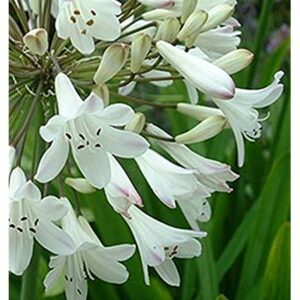Description
Garden Advice Notes
Symphytum Wisley Blue is a perennial herbaceous plant that is commonly known as comfrey. It is a cultivar of the Symphytum officinale species, which is native to Europe and Asia.
Symphytum Wisley Blue has attractive blue flowers that bloom in late spring and early summer. The flowers are bell-shaped and grow on spikes that can reach up to 2 feet in height. The leaves are large, broad, and hairy, and they grow in a rosette at the base of the plant.
This plant is commonly used in gardens as a border plant or as a ground cover, as it spreads easily through its rhizomes. It prefers moist, well-drained soil and partial shade to full sun.
Comfrey has been used for medicinal purposes for centuries, as it is believed to have anti-inflammatory and analgesic properties. However, it should be used with caution as it contains pyrrolizidine alkaloids which can be harmful if ingested in large quantities.
It is also important to note that Symphytum Wisley Blue can be invasive, so it is best to plant it in an area where it can spread without causing harm to other plants or ecosystems.
Location-Symphytum Wisley Blue can grow in a range of locations, but it prefers partial shade to full sun. In its native habitat, it grows along riverbanks and in damp meadows, so it can tolerate wet conditions.
In general, this plant grows best in areas with cool and temperate climates. It is hardy to USDA zones 4 to 9, which means it can tolerate winter temperatures as low as -30°F (-34°C).
In terms of location, Symphytum Wisley Blue can be used in a variety of garden settings, such as border plantings, woodland gardens, or cottage gardens. It also works well as a groundcover, as it can quickly spread to fill in bare areas.
However, it is important to note that Symphytum Wisley Blue can be invasive, so it is recommended to plant it in a location where it can spread without causing harm to other plants or ecosystems.
Pest and disease problems-Symphytum Wisley Blue is generally a hardy plant and is not often affected by pests or diseases. However, like all plants, it can be susceptible to certain issues.
One of the main pests that can affect Symphytum Wisley Blue is slugs and snails. They can damage the foliage and flowers, leaving large holes or feeding on the leaves. To control slugs and snails, it is recommended to use physical barriers such as copper tape or eggshells around the plants or use organic methods like beer traps.
Another pest that can affect comfrey is root knot nematodes, which can cause stunted growth and deformities in the roots. Crop rotation and soil solarization can help control these pests.
As for diseases, comfrey is relatively resistant to many common plant diseases. However, it can be susceptible to root rot if grown in soil that is too wet or poorly drained. To prevent root rot, it is important to ensure proper soil drainage and avoid overwatering.
In addition, comfrey can be affected by powdery mildew, a fungal disease that causes a white powdery growth on the leaves. Good air circulation and avoiding overhead watering can help prevent powdery mildew. If necessary, a fungicide can also be used to control the disease.
Stem cuttings can also be taken in the spring or fall. Select healthy stems and cut them to about 4-6 inches in length. Remove the lower leaves and plant the stem cuttings in a pot or directly in the ground, making sure to keep the soil moist until new roots have formed.
Comfrey can also be propagated from seed, but this method is less common as the seeds are not always reliable and can take longer to establish.
Regardless of the propagation method, it is important to keep the soil moist and avoid disturbing the newly planted cuttings or divisions until they are established. Comfrey is a fast-growing plant and can quickly establish itself in a new location.
Pruning, cutting back and dividing-Symphytum Wisley Blue is a relatively low-maintenance plant that does not require frequent pruning or cutting back. However, to keep the plant looking neat and to prevent it from becoming too leggy, it can be trimmed back after flowering or in early spring.
When trimming back, cut the stems down to about 2-3 inches above the ground level. This will encourage new growth and keep the plant compact.
Dividing is not necessary every year, but it can be done every 3-4 years to rejuvenate the plant and prevent overcrowding. The best time to divide comfrey is in the spring or fall when the plant is dormant. To divide, dig up the entire plant and use a sharp tool to separate the roots into smaller sections. Replant each section in a new location, making sure to water well and keep the soil moist until the new plant becomes established.
It is important to note that comfrey can be invasive, so it is important to control its spread by dividing and transplanting every few years or by removing any unwanted growth as soon as it appears.
Please note our plants in most instances are delivered by our own GardenAdvice expert gardeners. Our standard UK delivery charge is £25 or if you are a MyGardenTeam member delivery is free
Our plants are guaranteed for 24 months for more details Click Here
























Reviews
There are no reviews yet.